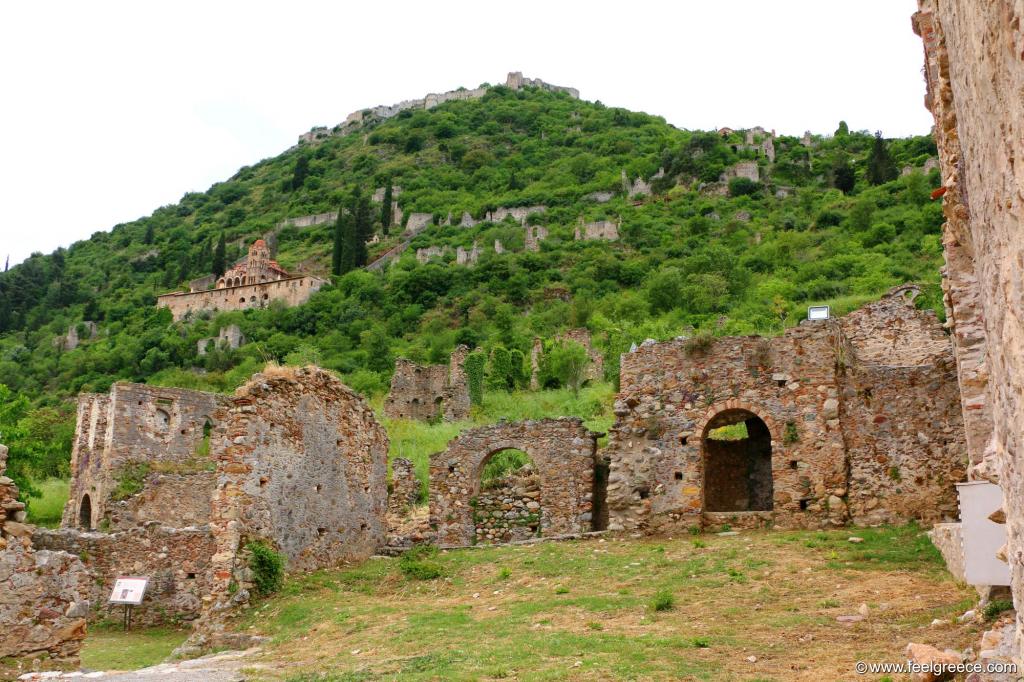Mystras

Mystras is a Medieval fortified city founded in 13th century and recognized as the ”Wonder of the Morea” and the second Constantinople of the Byzantine empire. The city was founded when William of Villehardouin, a crusader prince, built a castle on the top of large hill near the ancient Sparta. The fortification changed hands few times between Byzantines and Frankish crusaders. In late 13th, 14th and early 15th centuries Mystras was the capital of Despotate of Morea, a province of the Byzantine Empire. A large and prosperous city developed on the hill and the fortifications extended few times thus forming the Inner, Middle and Outer city. The city flourished and many public and religious buildings were built. The palaces were the second home for the Byzantine emperors. In 1460 the city was surrendered to the Ottoman emperor Mehmed II and a long period of decline started. The Venetians briefly occupied it from 1687 to 1715. The city was liberated in 1821 and shortly after this deserted when the last inhabitants moved to the newly founded city of Sparti.
Tourists can enter Mystras from two entrances - the Main and the Upper gate (both reachable by car). It is recommended to enter via the lower main entrance and have plenty of time to spend once inside. Once inside visitors will step back in time, walk between fortress walls, enter palaces and monasteries, stumble upon ancient church frescoes and enjoy the breathtaking views. Once on the top of the hill, from the acropolis, there is spectacular view to the surrounding valleys and mountains. The most curious people can spend a whole day exploring the secrets of Mystras. There are many direction signs and information boards.
Important monuments and interesting places:
1 - Main Gate - the fortified entrance of the outer walls. It is the main entrance for the tourists.
2 - Metropolis (Saint Demetrios church) - is near the Main Gate. The church was built at the end of 13th century by the Byzantines. The interior is covered with paintings in various styles due to the many painters and craftsmen engaged through the years.
2 - Museum - housed in the Saint Demetrios church buildings. The museum exhibits collections of Byzantine sculptures, jewellery, pottery, coins, fresco fragments, icons, books, clothes and more.
3 - Evangelistria - small church with preserved frescoes and burial grounds next to it.
4 - Saint Theodoroi church - built beside the main thoroughfare of the Lower City. The stories tell that here Constantine XI Palaiologos was crowned emperor, on the flagstone with with the carved two-headed eagle.
5 - Hodegetria (Aphentiko) church - small church incorporated into Brontochion Monastery as the monasterys catholicon by abbot Pachomius.
6 - Monemvasia Gate - also known as Sideroporta (Iron Gate). Impressive gate in the inner fortification walls.
7 - Saint Nicholas church
8 - Palace complex - the seat of Despotate of Morea and second home for the Byzantine Emperor. The palace buildings dominate the open area of the Upper City were built between 13th and 15th century. The buildings contain the throne room, sleeping quarters, barracks, cisterns, assembly rooms, administrative and storage areas.
9 - Nauplias Gate
10 - Upper gate - fortified entrance in the outer wall, high on the hill and bellow the acropolis. The second entrance for tourists.
11 - Saint Sophia church - the palace church, served also as a tomb. Under the floors of the church there are graves of the members of the aristocracy. The tombs of the distinguished figures are placed in the chapel.
12 - Small Palace
13 - Citadel - The Acropolis of Mystras. Built on the highest point of the town, the fortress was the center of the fortifications. It has two walls, gates, cisterns, garrison headquarters and various auxiliary buildings.
14 - Mavroporta (the Black Gate)
15 - Pantanassa monastery - it was built by Ioannis Frankopoulos, the ruler of the Despotate of Morea. It was dedicated to the Mother of God, the Virgin Pantanassa, and inaugurated in 1428.
16 - Taxiarchis
17 - Frankopoulos House
18 - Perivleptos - active monastery with the church attached to a rock cave. The church walls are covered with colored frescoes.
19 - Saint Georgios church
20 - Krevata House
21 - Marmara (entrance)
22 - Saint Gianniki church
23 - Laskaris House
24 - Saint Christopher church
25 - Ruins
26 - Saint Kyriaki church
Photos
Address and contacts
highlights: the second Constantinople of the Byzantine empire, historic sight in Laconia Region, Peloponnese, Greece





